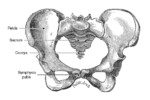Difference between revisions of "Pelvis - Anatomy & Physiology"
Jump to navigation
Jump to search
| Line 23: | Line 23: | ||
==Pelvic Joints and Ligaments== | ==Pelvic Joints and Ligaments== | ||
| − | |||
*'''Pelvic Symphysis''': secondary cartilaginous joint that ossifies with age and may expand in parturition | *'''Pelvic Symphysis''': secondary cartilaginous joint that ossifies with age and may expand in parturition | ||
*'''Sacroiliac joints''': synovial joints combined with fibrous joints | *'''Sacroiliac joints''': synovial joints combined with fibrous joints | ||
| Line 30: | Line 29: | ||
**Dog: stout cord extending between the sacrum and lateral ischial tuberosity | **Dog: stout cord extending between the sacrum and lateral ischial tuberosity | ||
**Cat: not present | **Cat: not present | ||
| − | **Ungulates: '''Sacrosciatic ligament''' expands to a broad | + | **Ungulates: '''Sacrosciatic ligament''' expands to a broad sheep |
| + | Video Link: *[http://stream2.rvc.ac.uk/Frean/sheep/SacroSciaticLigament.wmv Sacrosciatic Ligament of the Sheep, Copyright RVC 2008] | ||
Revision as of 15:34, 13 August 2008
Pelvic Girdle
- Two symmetrical halves: hip bones (ossa cosarum) meet at pelvic symphysis ventrally and articulate with sacrum dorsally
- Hip Bones:
- Three bones develop from separate ossifications within a single cartilage plate
- Ilium: craniodorsal, extends obliquely forward from hip to articulate with sacrum
- Cranial wing varies between species
- Dorsally, forms sacral tuber more prominent in large animals than dogs and cats
- Ventrally, forms tuber coxae, or the point of the hip
- Margin of the wing is known as the iliac crest
- Body is deeply excavated for attachment of the gluteus medius
- Greater Sciatic Notch on dorsal border of the wing is cut away at its junction with the shaft to allow the sciatic nerve passage en route to the hind limb
- Pubis : extends medially from the joint to form cranial pelvic floor
- L-shaped to give two branches: cranial (acetabular) and caudal (symphysial)
- Ischium: caudal, forms most of pelvic floor
- Ischial tuberosity is formed by the caudolateral corner of the horizontal plate of the ischium
- The Pelvic Symphysis comprises both pubis and ischium
- The Acetabulum"" provides the socket to the joint of the hip, and is comprised of all three bones of the pelvis
- Species differences:
- Larger species have a more vertical ilium, bringing the sacroiliac joint (and with it the weight of the trunk) closer to the hip
- Smaller species have an oblique ilium
Pelvic Joints and Ligaments
- Pelvic Symphysis: secondary cartilaginous joint that ossifies with age and may expand in parturition
- Sacroiliac joints: synovial joints combined with fibrous joints
- Transmits the weight of the trunk to the hindlimbs
- Sacrotuberous ligament varies tremendously between species, caudal edge is palpable
- Dog: stout cord extending between the sacrum and lateral ischial tuberosity
- Cat: not present
- Ungulates: Sacrosciatic ligament expands to a broad sheep
Video Link: *Sacrosciatic Ligament of the Sheep, Copyright RVC 2008
